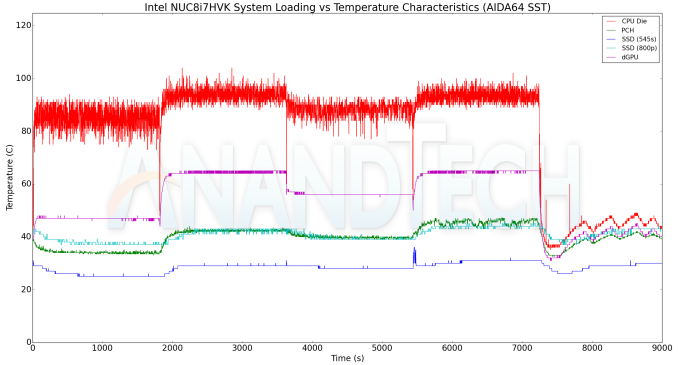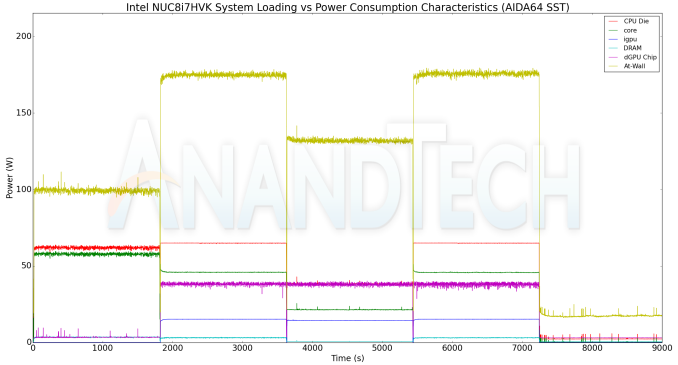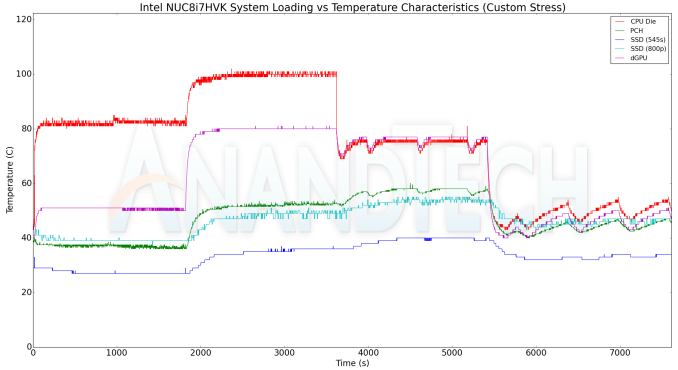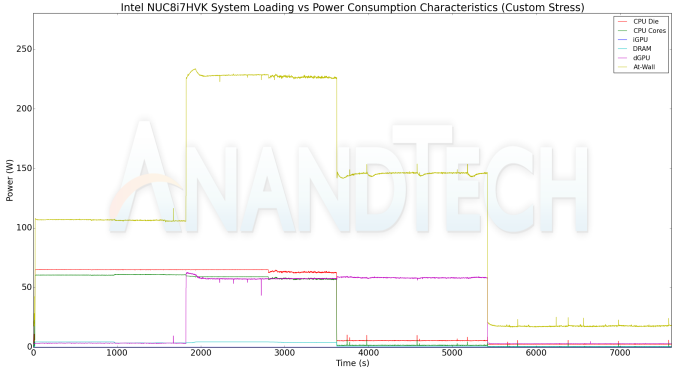The Intel NUC8i7HVK (Hades Canyon) Review: Kaby Lake-G Benchmarked
by Ganesh T S on March 29, 2018 1:00 PM ESTPower Consumption and Thermal Performance
The power consumption of the NUC8i7HVK at the wall was measured with a 4K display (LG 43UD79B) being driven through the HDMI port in the rear. In the graphs below, we compare the idle and load power of the system with other high-performance SFF PCs that we have evaluated before. For load power consumption, we ran our own custom stress test (Prime95 and FurMark) as well as the AIDA64 System Stability Test with various stress components, and noted the maximum sustained power consumption at the wall.


The power efficiency is pleasing - not only does the NUC have the lowest idle power, it also comes in the middle of the pack from a loading perspective (closer to the systems with the 65W TDP desktop processors).
Our thermal stress routine starts with the system at idle, followed by four stages of different system loading profiles using the AIDA64 System Stability Test (each of 30 minutes duration). In the first stage, we stress the CPU, caches and RAM. In the second stage, we add the GPU to the above list. In the third stage, we stress the GPU standalone. In the final stage, we stress all the system components (including the disks). Beyond this, we leave the unit idle in order to determine how quickly the various temperatures in the system can come back to normal idling range. The various clocks, temperatures and power consumption numbers for the system during the above routine are presented in the graphs below.
The cores manage to consistently stay above the rated clock (3.1 GHz) under all loading conditions. Given the higher power level (65W) that the CPU is configured for, we find that it stays close to 3.9 GHz till the CPU die starts to approach the 100C junction temperature. The thermal solution manages to easily keep the die below Tjmax while operating the cores at the rated clock.
The measurement of the power consumption presents some challenges due to the dynamic power sharing technology employed by Intel to share the package TDP across the CPU and the GPU. Currently, hardware monitoring programs are able to tap into the CPU die power (being misinterpreted as CPU package power consumption, while it actually appears to be just the CPU die power), the IA cores power (logically closer to the CPU die power, unless the iGPU is active), DRAM power consumption (refers to the SODIMMs, and not the HBM memory), and the Radeon GPU's chip power consumption. In almost all our previous system reviews, the at-wall power consumption has been close to the sum of the CPU package power and discrete GPU power (which accounting for the power consumption of the DRAM, physical disks etc.). However, in the case of the NUC8i7HVK, the at-wall power consumption is substantially higher. In the AIDA64 stress tests, we see that the CPU die power tracks the sum of the iGPU and IA cores power - around 65W, as expected. The dGPU power is only around 35W, but the maximum at-wall power consumption is as high as 175W. We are still looking into the reasons for this anomalous readings, but, it is likely that the current hardware monitoring programs are missing some key power consumption aspects of the KBL-G package.
We repeated the same observations with our legacy stress test using the latest versions of Prime95 and Furmark. Prime95 immediately pushes the core clocks to the rated speed (3.1 GHz) with infrequent spikes to 3.9 GHz, and this allows the cooling solution to maintain the CPU die at around 80C. However, adding Furmark to the mix stresses the solution, and makes it unable to prevent the die from approaching the 100C junction temperature. At that point, we see more aggressive scaling back of the cores' frequency to the rated speed.
The combination of Prime95 and Furmark makes the at-wall power consumption to go as high as 230W. However, the component power readings from the monitoring programs still show only 65W for the CPU die and around 60W for the Radeon GPU.
















124 Comments
View All Comments
ianmills - Thursday, March 29, 2018 - link
I get the form factor but would have been nice to put a couple amd discrete gpus in the benchmarks like a 580versesuvius - Thursday, March 29, 2018 - link
There are mini-PC reviews with discrete GPUs and not a 580 but a NVIDIA GeForce GTX 1080 (8GB GDDR5x) in Zotac ZBOX MAGNUS EK71080.Crazyeyeskillah - Thursday, March 29, 2018 - link
this costs $1700Crunchy005 - Thursday, March 29, 2018 - link
Yeah with a $200 optane drive that is in no way necessary.Samus - Saturday, March 31, 2018 - link
It costs 1000. And that’s retail. It will likely be on sale for 700 in a few months. Adding $80 in RAM and $100 512GB SSD like the drive Mushkin just announced keeps it safely under $1200.$1700 configured price has no influence on the gaming performance of this machine.
sutamatamasu - Thursday, March 29, 2018 - link
What about driver?Intel use default Radeon Software or use custom driver for it? Since the six display goes to GPU
jjj - Thursday, March 29, 2018 - link
So not testing it against any relevant GPU because serving the reader is less important that selling hardware for the modern pseud-press.Typical for AT, God forbid test an ultrabook vs other laptops or a Surface in gaming. Mislead, bend reality to sell the hardware and that's your job. Objectivity, ethics, decency, those are long gone.
ganeshts - Thursday, March 29, 2018 - link
Which part of the 'Gaming notebooks compared' section didn't you read ?ToTTenTranz - Thursday, March 29, 2018 - link
I don't agree with the way the "protest" was made, but the fact is that you guys managed to not compare to a single one of the discrete GPUs that Kaby Lake proposes to compete with (as seen through Intel's own slides about Kaby Lake G): the notebook GTX1060, GTX1060 Max-Q and GTX 1050 Ti.Instead you compared Kaby G with a bunch of 3-4 year-old Maxwell solutions and GP104 discrete cards that are very obviously out of Kaby G's range.
Arbie - Thursday, March 29, 2018 - link
@jjj - Silly rants are supposed to be posted in Wccftech, not here. And mainstream GPUs were addressed: "... the Radeon GPU slotted between the GTX 960 and GTX 980 in terms of performance." If you really need +/- 1 FPS for some specific GPU, there are lots of results here you can use to compare. The question with a box like this is not whether it beats a desktop, but whether it will run advanced games at all. Question answered. Go take your meds.